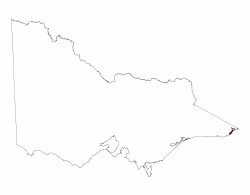7.3.6 Terraces on bedrock (Mallacoota)
7. Eastern Plains (EP)
7.3 High level terraces and fans
| In the far east of the state the topography near the coast consists of peneplain like forms, which has been formed on Palaeozoic sediments with the addition of colluvial, alluvial and aeolian derived material. These low lying areas occur in the Mallacoota area either side of the Whallagra River as it opens out into a lagoon (specifically a Ria). These forms can be observed on the coast where low cliffs expose the folded sediments. These low lying areas are intermingled with low lying areas of Neogene origin (with a range of regolith from coarse gravel to clay). Much of the topography is probably due to sea level changes associated with Quaternary glacial maxima events and subsequent submarine planation followed by dissection as well as aeolian deposition. The coastal region is influenced by climatic patterns associated with southern coastal NSW. The vegetation was Forest prior to clearing including Southern Mahogany as a distinctive species associated with the distinctive climate. Depending on aeolian influences the soils are texture contrast with varying amounts of sandy material over clayey material (Chromosols), which has formed on the older Palaeozoic sediments. |  |


